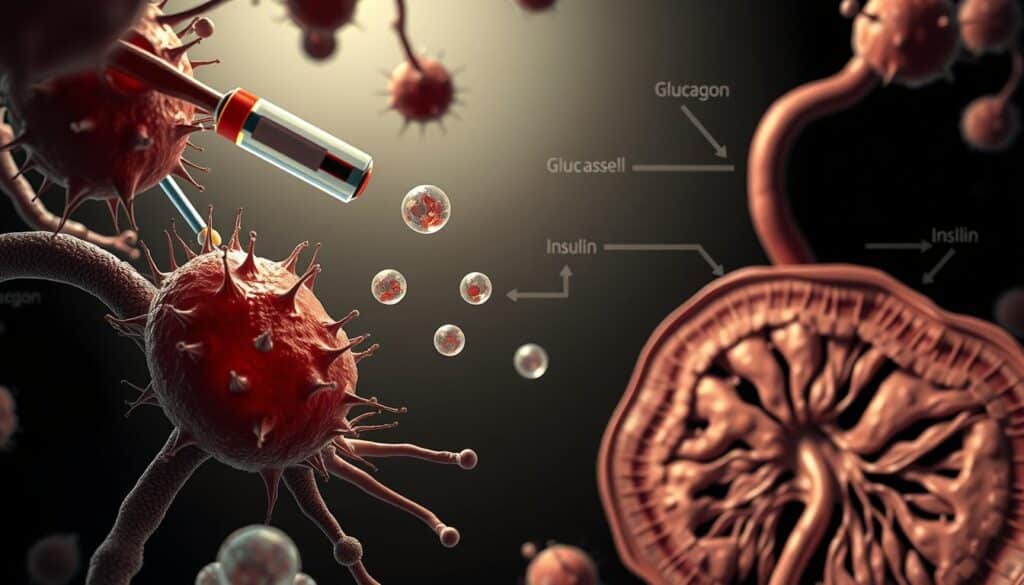Understanding how drinking affects your body’s ability to manage blood sugar levels is critical for long-term health. Research shows frequent heavy drinking may impair insulin sensitivity, making it harder for cells to absorb glucose. This raises important questions about diabetes risk, especially for those with existing health conditions.
Studies from Diabetes UK reveal that consuming one pint of lager equals roughly 180 calories—similar to a slice of pizza. Over time, excessive consumption can contribute to weight gain and pancreatic strain. Chronic pancreatitis, often linked to prolonged alcohol use, directly impacts the organ’s ability to produce insulin.
Your liver plays a dual role: processing toxins and regulating glucose levels. When prioritizing alcohol metabolism, it may neglect blood sugar management. This imbalance can lead to dangerous spikes or drops, particularly for those taking diabetes medications.
Emerging data suggests a relationship between regular intake and type 2 diabetes development. However, moderate habits might not carry the same risks. Later sections will explore actionable strategies for balancing enjoyment with health priorities, backed by NHS guidelines and clinical research.
Alcohol and Diabetes: A Comprehensive Overview
Diabetes impacts over 37 million Americans, with distinct biological mechanisms driving its two primary forms. Recognizing these differences helps clarify how lifestyle choices—including drinking habits—affect blood sugar levels and overall health.
Understanding Diabetes and Its Types
Type 1 diabetes occurs when the immune system attacks insulin-producing cells in the pancreas. This autoimmune condition often appears early in life and requires daily insulin management. Type 2 diabetes, accounting for 90-95% of cases, develops when the body resists insulin or doesn’t produce enough. Excess weight, inactivity, and genetic factors like ethnicity elevate risk.
Normally, insulin helps cells absorb glucose from the bloodstream. Disruptions in this process lead to unstable sugar levels, which can damage organs over time. Research shows African American and Hispanic populations face higher risk factors for Type 2 due to both genetic and socioeconomic influences.
Alcohol Consumption Patterns in the United States
Approximately 66% of U.S. adults report drinking yearly, with 7% engaging in heavy drinking (15+ weekly drinks for men, 8+ for women). The average consumer has about 4.6 drinks weekly, though habits vary by age and region. Frequent intake strains the liver and pancreas—organs vital for glucose regulation.
Studies link sustained consumption to fatty liver disease and impaired insulin sensitivity. While moderate drinking might not directly cause diabetes, it complicates management for those already diagnosed. Later sections will explore strategies to minimize these risks without sacrificing lifestyle balance.
How Alcohol Affects Blood Sugar and Insulin Levels
Your body’s response to alcohol directly influences crucial metabolic processes. When you drink, your liver prioritizes breaking down toxins over regulating glucose. This shift can lead to unstable blood sugar levels, especially during fasting periods.

The Impact on Fasting Glucose
Research presented at the American Physiology Summit shows heavy drinkers have 12% higher fasting glucose levels than non-drinkers. Alcohol’s empty calories prompt the liver to release stored sugar, creating spikes. Over time, this pattern may strain your body’s ability to maintain balance.
Insulin Sensitivity and Metabolic Responses
Frequent consumption reduces cells’ responsiveness to insulin by up to 25%, per recent studies. Your pancreas then works harder to produce more hormone, accelerating wear. This metabolic double-bind complicates blood sugar management for those monitoring their health.
Can alcohol cause diabetes
Exploring the connection between drinking habits and metabolic health reveals complex interactions. While no single factor directly causes diabetes, sustained patterns matter. Research from Diabetes UK shows heavy drinkers face 45% higher diabetes risk compared to moderate consumers. This aligns with NHS data linking excessive intake to pancreatic stress and impaired insulin production.

Review of Scientific Research and Risk Factors
A 2023 meta-analysis of 850,000 participants found those consuming 4+ daily drinks had 28% higher fasting glucose levels. Alcohol consumption alters liver function, reducing its ability to regulate blood sugar during sleep. However, studies note these effects vary based on drinking frequency and genetic makeup.
Key limitations exist. Most trials rely on self-reported data, potentially underestimating true intake levels. Animal studies suggest ethanol directly damages pancreatic cells, but human evidence remains inconclusive.
Genetic and Lifestyle Contributions
Your DNA plays a role. A Johns Hopkins study identified three gene variants that amplify alcohol’s impact on insulin sensitivity. Individuals with these markers see 50% greater metabolic disruption from regular drinking.
Lifestyle choices compound these risks. Pairing alcohol with sugary mixers or late-night snacks accelerates blood sugar spikes. Conversely, moderate red wine consumption with meals shows neutral effects in some populations. Balance remains key—neither biology nor behavior acts alone in diabetes development.
Alcohol-Induced Organ Damage: Liver, Pancreas, and Beyond
Your liver and pancreas work tirelessly to maintain metabolic balance. When exposed to frequent alcohol consumption, these organs face structural changes that impair their critical functions. This damage creates ripple effects across your body’s ability to manage blood sugar and insulin production.
Effects on Liver Function and Glucose Regulation
The liver filters toxins while storing and releasing glucose as needed. Heavy intake forces it to prioritize alcohol breakdown, often neglecting glucose regulation. NHS data shows 40% of heavy drinkers develop fatty liver disease—a condition reducing insulin effectiveness by up to 34%.
Over time, scar tissue replaces healthy cells, permanently disrupting sugar management. This process explains why 22% of cirrhosis patients eventually develop type 2 diabetes. Even three drinks daily can slow your liver’s response to blood sugar changes within six months.
Chronic Pancreatitis and Its Connection to Diabetes
Repeated alcohol exposure inflames the pancreas, damaging insulin-producing cells. Studies indicate 70% of chronic pancreatitis cases stem from prolonged consumption. Patients with this condition face 30% higher diabetes risk due to impaired hormone production.
Your pancreas also releases enzymes to digest food. Alcohol disrupts this process, creating toxic buildups that further harm tissue. Moderate drinkers aren’t immune—research links four weekly drinks to measurable pancreatic stress over five years.
Left unchecked, organ damage amplifies health complications. Heart disease risks rise 18% in those with alcohol-related liver conditions. Early intervention and reduced intake help preserve function, supporting long-term metabolic stability.
Safe Drinking Practices for Individuals with Diabetes
Managing diabetes requires careful attention to daily choices, including beverage consumption. While complete abstinence isn’t always necessary, strategic planning minimizes health risks. UK guidelines suggest limiting intake to 14 units weekly—roughly 6 pints of beer or 7 glasses of wine.
Setting Boundaries for Moderation
Stick to 1-2 drinks per day if approved by your doctor. One drink equals 12 oz beer, 5 oz wine, or 1.5 oz spirits. Never exceed these limits—excess alcohol consumption can mask hypoglycemia symptoms. Pair each drink with water to stay hydrated and slow absorption.
Guarding Against Blood Sugar Drops
Eat protein-rich snacks before drinking to stabilize blood sugar. Avoid sugary cocktails—opt for soda water with lime instead. Continuous glucose monitors help track levels in real time during social events.
Always carry glucose tablets or juice boxes. Inform friends about your condition, and wear medical ID jewelry. Check blood sugar before bed if you’ve consumed alcohol, as delayed drops can occur overnight.
Consult your care team about adjusting medications when drinking. Personalized advice accounts for your specific diabetes type, weight, and overall health status. Balance remains achievable through informed choices and vigilance.
Balancing the Benefits and Risks of Alcohol Consumption
Recent studies reveal a nuanced connection between moderate drinking and metabolic health. While excessive intake heightens diabetes risk, controlled patterns might offer unexpected advantages. The key lies in understanding where benefits end and dangers begin.
Cardiovascular Benefits of Moderate Drinking
Data from the American Physiology Summit shows 1-2 daily drinks may improve heart health by 15% in some adults. Red wine’s polyphenols support blood vessel flexibility, while light beer consumption correlates with higher HDL (“good” cholesterol). These effects fade beyond 2 drinks, turning protective habits into health risks.
Practical Tips for Smart Consumption
Space drinks with water to slow absorption. Pair alcohol with protein-rich meals—grilled chicken or nuts stabilize blood sugar. Avoid sugary mixers; opt for soda water with citrus instead.
Binge drinking (4+ drinks in 2 hours) spikes glucose levels by 30% and strains the liver. Stick to UK guidelines: 14 weekly units max. Always consult your doctor before making changes if managing diabetes.
Balance requires vigilance. Track reactions using glucose monitors and adjust habits accordingly. Personalized advice from healthcare providers ensures your approach aligns with unique risk factors and lifestyle needs.
Conclusion
The interplay between alcohol intake and blood sugar control remains a critical consideration for long-term health. Research highlights how excessive consumption strains pancreatic function and disrupts glucose regulation, increasing diabetes risk. Genetic factors and lifestyle choices further shape individual susceptibility, making personalized assessments essential.
Moderation proves vital—stick to guidelines from trusted sources like the NHS, which recommend limits to protect organ function. Pairing drinks with nutrient-rich foods and monitoring blood sugar levels helps mitigate sudden spikes or drops. Those managing metabolic conditions should prioritize open dialogue with healthcare teams.
While studies note potential cardiovascular benefits from limited intake, these advantages diminish rapidly beyond moderate thresholds. Regular check-ups and awareness of family history empower smarter decisions. Remember: balance hinges on understanding your body’s unique responses.
For actionable strategies, consult Diabetes UK’s resources or schedule a professional consultation. Proactive health management turns informed choices into lasting well-being—start assessing your habits today.
FAQ
How does drinking affect blood sugar management?
Alcohol can interfere with glucose regulation by slowing liver function, which may lead to unstable blood sugar levels. Heavy consumption often causes spikes or drops, especially if you take insulin or medications like sulfonylureas. Always monitor closely when drinking.
What’s the link between heavy drinking and type 2 diabetes?
Chronic excessive intake increases insulin resistance and damages the pancreas, raising your risk of developing type 2 diabetes. Studies show a 40% higher likelihood in heavy drinkers compared to moderate consumers.
Are certain alcoholic drinks safer for those with diabetes?
Dry wines, light beers, and spirits mixed with zero-sugar options (like soda water) have fewer carbs, reducing glucose spikes. Avoid sugary cocktails, sweet wines, and regular beers, which can destabilize levels.
Can occasional drinking lower diabetes risk?
Moderate intake (1 drink/day for women, 2 for men) may improve insulin sensitivity and heart health, per the American Diabetes Association. However, benefits depend on individual factors like genetics and overall lifestyle habits.
How does alcohol worsen liver-related diabetes risks?
The liver prioritizes metabolizing alcohol over regulating glucose, which can lead to prolonged high blood sugar. Over time, fatty liver disease from heavy drinking also heightens insulin resistance and type 2 diabetes risks.
What precautions should I take if I drink with diabetes?
Never drink on an empty stomach, check glucose levels frequently, and keep fast-acting carbs nearby to treat lows. Inform friends/family about hypoglycemia symptoms, and avoid binge drinking to prevent emergencies.
Does alcohol interact with diabetes medications?
Yes. Insulin and sulfonylureas combined with alcohol raise hypoglycemia risks. Metformin with heavy drinking may cause lactic acidosis. Consult your doctor about adjusting doses or timing when consuming alcohol.


